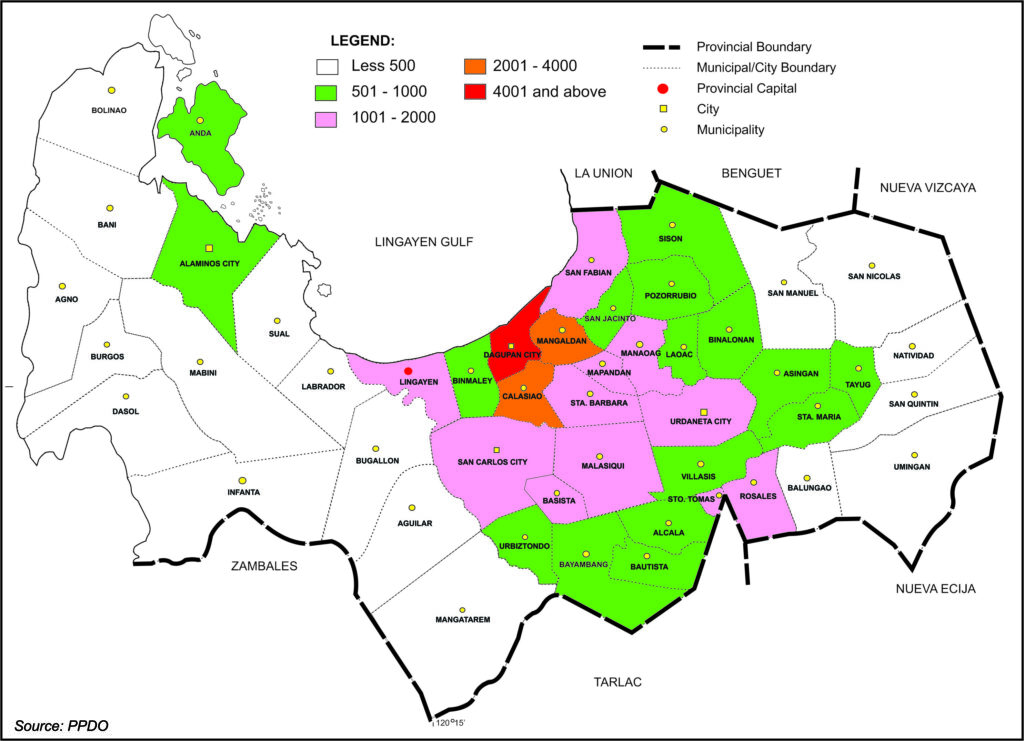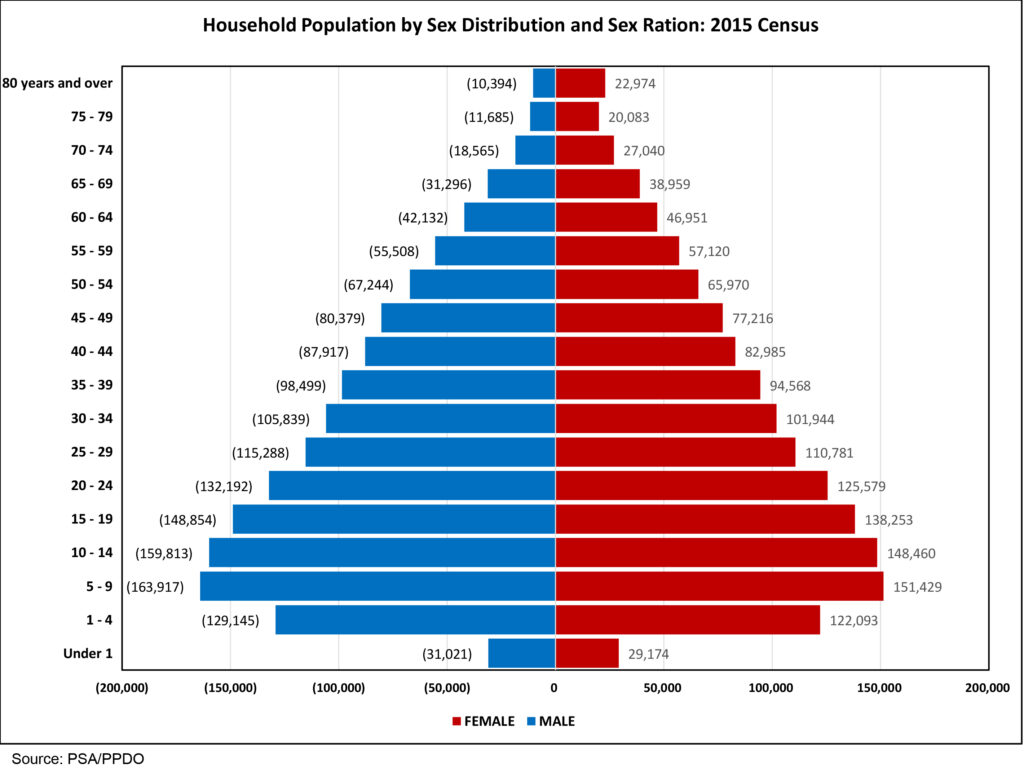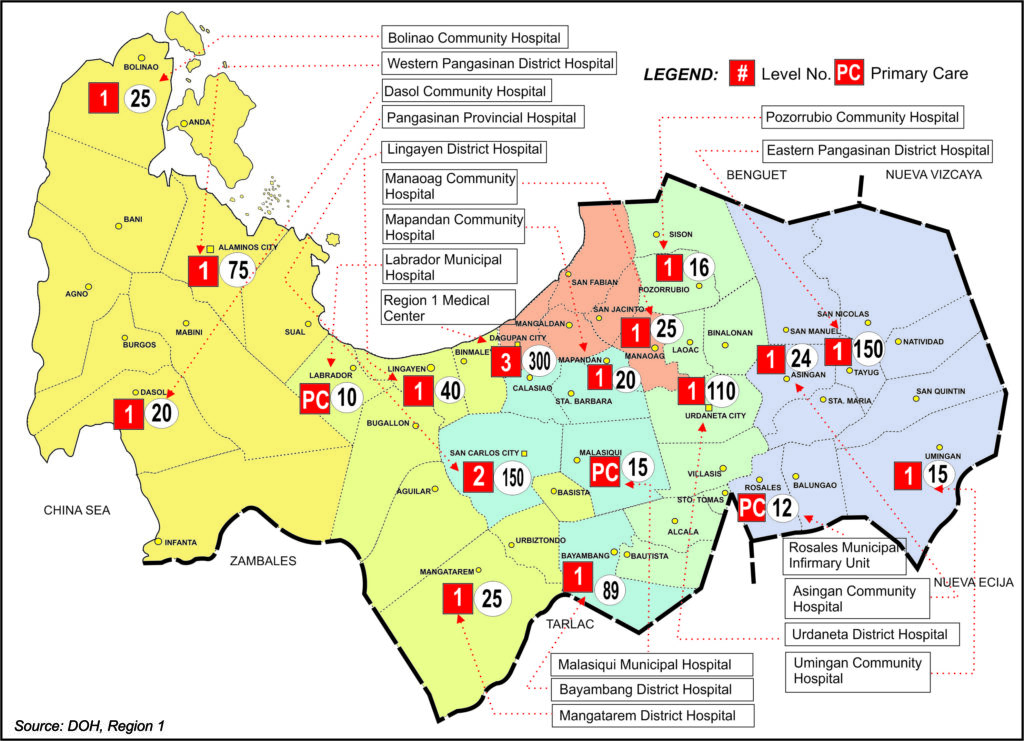Population Size, Growth Rate and Population Density
Based from the 2020 census of population, Pangasinan registered a total population of 3,163,190 and ranks sixth in the country. Compared to 2015 Census, Pangasinan was surpassed by Rizal and Cebu this 2020 Census. Among the four (4) cities and forty-four (44) municipalities of Pangasinan, San Carlos City had the largest population with 205,424 persons. This is followed by Dagupan City with 174,302, the City of Urdaneta with 144,577, and the municipalities of Malasiqui with 143,094 and Bayambang with 129,011 number of persons. These two municipalities surpassed the hundred thousand mark in population count higher than the population of Alaminos City of 99,397. On the other hand, the municipality of Sto. Tomas with population of 14,878 persons is the least populated area in 2020 census.

The total household population (Census 2015) for both male and female is 2,951,267 wherein 1,489,688 are male and 1,461,579 are female which both genders represent 50% of the total household population.
In terms of the distribution by age and sex, there were more males than females in age group 0 – 54 in 2015 Census with the males comprising 51.0 percent of these age groups. In contrast, there were more females than males in the older age group 55 years old and over. The males in these groups made up of 44.31 percent.

The province’s household population is 2,951,267 and the total number of households is 674,575 with an average household size of 4.4.
Based on the average annual growth rate of 1.85%, the projected number of households is 740,661, which shows an increase of 1.9% from the previous data with 726,855.
Based on the 2010 Census, the province has 574 urban barangays with a population of 1,458,402 and 790 rural barangays with a population of 1,321,460.
Health
In 2020, there were a total of 59 public and private hospitals with a total number bed capacity of 1,106 for government and 1,334 for private hospitals.

As per DOH data, there were 77 birthing homes established in the province. These healthcare facilities were lodged in private hospitals and Rural Health Units.
In addition, the province had 69 Rural Health Units (RHUs) and 623 Barangay Health Stations (BHS) complementing health service delivery to the populace.
From the different health services catered by different government hospitals, there were 87 doctors, 346 nurses, 53 dentists, 544 midwives, 14 nutritionist/dieticians and 66 medical technologists providing health care and medical treatment to various patients.
Respiratory Disease was the most prevalent morbidity case in the province registering 88,136 (CY 2020) cases which went down by 57.59% from 207,809 cases in the previous year (CY 2019). On the other hand, Heart Diseases which continue to be the leading cause of mortality in the province in 2020, increased by 4.97% or 166 deaths from 3,341 total number of deaths in 2019 to 3,507 deaths for the period under review. Pneumonia and Cancer followed, claiming 1,419 and 1,415 lives respectively.
The number of livebirths went down by 6.49% from 24,191 in 2019 to 22,620 in 2020 with crude birth rate of 7.71 (per 1,000 population). Meanwhile, the number of registered deaths increase by 8.23% from 11,522 registered deaths in 2019 to 12,470 in 2020 with a crude death rate of 4.25.
Social Welfare
The province had 1,451 child development centers/day care centers providing early childhood care and development to children 3-5 years old. A total of 47,750 day care children were (24,022 boys and 23,725 girls) served by 1,503 accredited child development workers/day care workers providing day care services.
The province had a total of 254,190 senior citizens excluding Dagupan City. Of these, 104,546 (41%) are males and 149,644 (59%) are females.
Education
Despite the Covid19 pandemic, public elementary enrolment still increased from 385,623 in the previous school year (SY 2019-2020) to 408,217 this SY 2020-2021 with a minimum percentage of 5.86%. Secondary enrolment also, increased by 0.12% from 227,114 to 227,386.
Pangasinan had sufficient public school teachers as evidenced by the teacher-pupil ratio of 1:27 for elementary and 1:24 for secondary level as against the planning standard of 1:45 for SY 2020-2021. On the other hand, the classroom-student ratio is 1:29 and 1:38 for elementary and secondary respectively. With the pandemic, modular and online classes or a combination of both are utilized in all schools.
As per data from the different DepEd Divisions (SY 2020-2021), the province has recorded a total of 303 government and 135 private schools teaching senior high school. From these schools, a total of 80,538 students were enrolled in government institutions while students enrolled under private schools have 26,666. This means that out of the 259,988 Junior High School from public and private school last year, a total of 152,784 students did not enroll in Senior High School in the province. This may have been one of the negative effects of the pandemic in the province.
Based from the Commission on Higher Education’s (CHED) report, there are 60 tertiary schools providing various courses of higher education in the province. A total of 91,106 students were enrolled for SY 2020-2021. Showing slight increase of 0.46% compared to its previous figure of 90,685. With the pandemic, transferees may have caused the slight increase of enrollees in college and universities in the province.
Meanwhile, data from TESDA provincial office recorded a total of 84 technical-vocational schools with a total enrolment of 11,435 (SY 2018-2019) showing a decrease of 305 or 3% compared to SY 2017 – 2018. The decrease may be attributed to the presence of Senior High School wherein one of its tracks is Technical-Vocational and Livelihood.
Employment
This year’s province employment rate is 86.67%, while the unemployment rate and underemployment rate is 13.33% and 17.29% respectively. While, the labor force participation rate of Pangasinan is 62.65% which comprises the total employed and unemployed population.
Based from the DOLE – RO1, the daily minimum wage rate for agriculture and non-agriculture industries/sectors ranges from P282.00 to P340.00 as per Wager Order No. RB 1-20. Effectivity date of this wage rate is on April 30, 2019.
Poverty Incidence
As per the Philippine Statistics Authority (PSA) survey, poverty incidence among families in Pangasinan continue to decrease from 16.9% in 2015 Annual Poverty Incidence and further reduced to 9.3% in 2018. The annual per capita poverty threshold of the province increased from P22,799 (CY 2015) to P27,828 (CY 2018).
Protective Service
The total number of PNP Officers and Police Non-Commission Officers serving the province totaled to 2,982 personnel. From this number, 2,770 are non-officers (including the non-uniform personnel) and 130 are officers.


